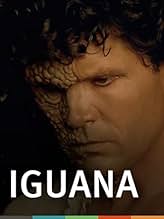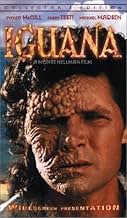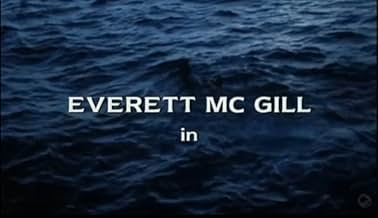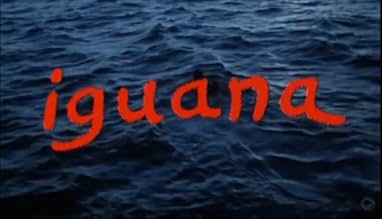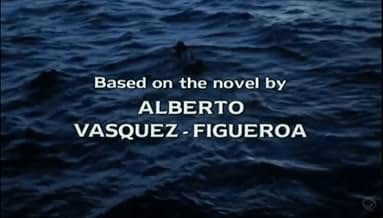En el siglo XIX, un hombre humillado por su desfiguración y apodado "iguana" por los lugareños abusivos se adueña de una isla de la que se proclama líder. Una pareja vara en la isla y se con... Leer todoEn el siglo XIX, un hombre humillado por su desfiguración y apodado "iguana" por los lugareños abusivos se adueña de una isla de la que se proclama líder. Una pareja vara en la isla y se convierte en víctima de su nueva naturaleza sádica.En el siglo XIX, un hombre humillado por su desfiguración y apodado "iguana" por los lugareños abusivos se adueña de una isla de la que se proclama líder. Una pareja vara en la isla y se convierte en víctima de su nueva naturaleza sádica.
- Premios
- 1 premio en total
Maru Valdivielso
- Carmen
- (as Maru Valdivieso)
Amaia Merino
- Girl Who Sings
- (as Amaya Merino)
Timothy C. Ryan
- George
- (as Tim Ryan)
Argumento
¿Sabías que...?
- CuriosidadesDirector Monte Hellman never wanted to direct this movie. He referred to the production experience as ''terrible''.
- ConexionesReferenced in Adjust Your Tracking: The Untold Story of the VHS Collector (2013)
Reseña destacada
After less than encouraging outings like THE PIRATE MOVIE (1982), YELLOWBEARD (1983) and Roman Polanski's PIRATES (1986; partly shot over here in Malta), pirate movies in the 1980s were an incongruity – more so for one that was really a character study and filmed partly in Spanish, while incorporating sex, equally explicit language, gore and even horror trappings! It proved Hellman's return to the director's chair after 10 years in the wilderness – for which he was re-united with the leading man of his last, Fabio Testi (here allotted "special participation" status but actually essaying a large supporting and pivotal role) and dedicating it to that one's co-star Warren Oates who had died prematurely in the interim!
Apparently, the film and its source novel were inspired by a real person (the fanatical Queequeg character in Herman Melville's classic "Moby Dick" was also said to be based on him) and events: a harpoonist (played by Everett McGill and wearing make-up once again, following his turns as a caveman in QUEST FOR FIRE [1981} and a werewolf in SILVER BULLET {1985}!) is shunned and abhorred for his lizard-like countenance, over which he renounces God (by ostensibly invoking a zombie during a voodoo rite!) and wages war on the rest of mankind. Escaping his latest crew members' torments to a deserted island, he decides to lord it over the land and whoever happens to turn up there. Soon, he has a handful of slaves (two played by the sons of popular character actors, namely Robert Ryan and Robert Culp!), one a mute, yet another constitutes an early role for Michael Madsen but, above all, a free-spirited Spanish aristocrat (well played by the lovely Maru Valdivielso). In another unexpected – and potentially mystifying – touch, her life and McGill's occupy separate plot strands within the film until their paths eventually cross (their relationship making for a disturbing twist on the "Beauty And The Beast" theme).
Unfortunately, we do not really pity the protagonist's plight because he treats everybody as his inferior and enemy (even when he does show compassion during the very last scene, his actions are construed as criminal and inhuman!) – his deformity but also his sneaky, vengeful and domineering ways actually bring to mind 'The Phantom Of The Opera'! Madsen, Ryan (in a remarkable decapitation scene evoking a similar one in Werner Herzog's AGUIRRE, THE WRATH OF GOD {1973}) and the girl (whom he repeatedly rapes and ultimately impregnates!) get the worst deal from him, since the learned Culp teaches McGill how to read and write. "Iguana", as he is referred to, despite being given the evocative name Oberlus, harbors a particular grudge against the sadistic Testi (who struggles with the English dialogue throughout but, remarkably, has managed to retain his distinctively handsome looks): boarding the latter's ship, he single-handedly kills a couple of his mates, abducts him and blows up the vessel!
Incidentally, this specific bit of business takes place off-screen – which might give one the impression that Hellman is not interested in depicting action scenes: however, the inevitable showdown between McGill and Testi is certainly given its due. Still, the manner in which the villain perishes is deliberately left obscure and, in fact, the whole film (which Hellman personally edited) is filled with such ellipses: these include the afore-mentioned finale, where the crew of a Spanish galleon are about to land on the island in order to save the 'prisoners' and hopefully bring McGill to justice, yet we stick to the latter's personal dilemma without ever returning to them! This approach lends IGUANA a remarkably modern feel (the silken-soft visuals, then, seem to hark back to an earlier era in film-making, while the otherwise sluggish pace betrays its inherent artiness!), being also the mark of a true artist, without the need to resort to caricature and special effects as would prove the case with the recent PIRATES OF THE CARIBBEAN movies!
In the accompanying Audio Commentary Hellman describes this as being the most difficult shoot he was on, because producer Franco Di Nunzio (the man behind the notorious CANNIBAL HOLOCAUST {1980}!) would constantly fail to provide the necessary equipment. Apparently, so badly-distributed was the film that only 7 copies were ever made of it – indeed, when Hellman met Quentin Tarantino (on whose debut, RESERVOIR DOGS {1992}, he would serve as Executive Producer), the former was surprised the latter knew IGUANA at all! However, he praises other collaborators (cast, cinematographer – whom he came to in a roundabout way, having originally asked for the d.p. of THE SPIRIT OF THE BEEHIVE {1973} who had long been dead by that point, nor was he able to secure the services of his assistant on that celebrated film). When asked if he had watched Roman Polanski's ROSEMARY'S BABY {1968}, in view of the fact that the all-important infant's face is never shown, Hellman ventures to joke that they actually recruited the very same child for the role!
Apparently, the film and its source novel were inspired by a real person (the fanatical Queequeg character in Herman Melville's classic "Moby Dick" was also said to be based on him) and events: a harpoonist (played by Everett McGill and wearing make-up once again, following his turns as a caveman in QUEST FOR FIRE [1981} and a werewolf in SILVER BULLET {1985}!) is shunned and abhorred for his lizard-like countenance, over which he renounces God (by ostensibly invoking a zombie during a voodoo rite!) and wages war on the rest of mankind. Escaping his latest crew members' torments to a deserted island, he decides to lord it over the land and whoever happens to turn up there. Soon, he has a handful of slaves (two played by the sons of popular character actors, namely Robert Ryan and Robert Culp!), one a mute, yet another constitutes an early role for Michael Madsen but, above all, a free-spirited Spanish aristocrat (well played by the lovely Maru Valdivielso). In another unexpected – and potentially mystifying – touch, her life and McGill's occupy separate plot strands within the film until their paths eventually cross (their relationship making for a disturbing twist on the "Beauty And The Beast" theme).
Unfortunately, we do not really pity the protagonist's plight because he treats everybody as his inferior and enemy (even when he does show compassion during the very last scene, his actions are construed as criminal and inhuman!) – his deformity but also his sneaky, vengeful and domineering ways actually bring to mind 'The Phantom Of The Opera'! Madsen, Ryan (in a remarkable decapitation scene evoking a similar one in Werner Herzog's AGUIRRE, THE WRATH OF GOD {1973}) and the girl (whom he repeatedly rapes and ultimately impregnates!) get the worst deal from him, since the learned Culp teaches McGill how to read and write. "Iguana", as he is referred to, despite being given the evocative name Oberlus, harbors a particular grudge against the sadistic Testi (who struggles with the English dialogue throughout but, remarkably, has managed to retain his distinctively handsome looks): boarding the latter's ship, he single-handedly kills a couple of his mates, abducts him and blows up the vessel!
Incidentally, this specific bit of business takes place off-screen – which might give one the impression that Hellman is not interested in depicting action scenes: however, the inevitable showdown between McGill and Testi is certainly given its due. Still, the manner in which the villain perishes is deliberately left obscure and, in fact, the whole film (which Hellman personally edited) is filled with such ellipses: these include the afore-mentioned finale, where the crew of a Spanish galleon are about to land on the island in order to save the 'prisoners' and hopefully bring McGill to justice, yet we stick to the latter's personal dilemma without ever returning to them! This approach lends IGUANA a remarkably modern feel (the silken-soft visuals, then, seem to hark back to an earlier era in film-making, while the otherwise sluggish pace betrays its inherent artiness!), being also the mark of a true artist, without the need to resort to caricature and special effects as would prove the case with the recent PIRATES OF THE CARIBBEAN movies!
In the accompanying Audio Commentary Hellman describes this as being the most difficult shoot he was on, because producer Franco Di Nunzio (the man behind the notorious CANNIBAL HOLOCAUST {1980}!) would constantly fail to provide the necessary equipment. Apparently, so badly-distributed was the film that only 7 copies were ever made of it – indeed, when Hellman met Quentin Tarantino (on whose debut, RESERVOIR DOGS {1992}, he would serve as Executive Producer), the former was surprised the latter knew IGUANA at all! However, he praises other collaborators (cast, cinematographer – whom he came to in a roundabout way, having originally asked for the d.p. of THE SPIRIT OF THE BEEHIVE {1973} who had long been dead by that point, nor was he able to secure the services of his assistant on that celebrated film). When asked if he had watched Roman Polanski's ROSEMARY'S BABY {1968}, in view of the fact that the all-important infant's face is never shown, Hellman ventures to joke that they actually recruited the very same child for the role!
- Bunuel1976
- 30 jul 2011
- Enlace permanente
Selecciones populares
Inicia sesión para calificar y añadir a tu lista para recibir recomendaciones personalizadas
- How long is Iguana?Con tecnología de Alexa
Detalles
Taquilla
- Presupuesto
- 3.000.000 US$ (estimación)
- Duración1 hora 28 minutos
- Mezcla de sonido
- Relación de aspecto
- 1.85 : 1
Contribuir a esta página
Sugerir un cambio o añadir el contenido que falta

Principal laguna de datos
By what name was La iguana (1988) officially released in Canada in English?
Responde
